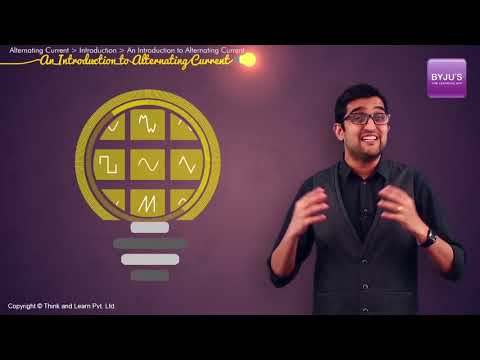Electric current flows in two ways as an alternating current (AC) or direct current (DC). The main difference between AC and DC lies in the direction in which the electrons flow. In DC, the electrons flow steadily in a single direction, while electrons keep switching directions, going forward and then backwards in AC. Let us learn more differences between them in the next few sections.
| Table of Contents: |
What is an Alternating Current (AC)?
In alternating current, the electric charge flow changes its direction periodically. AC is the most commonly used and most-preferred electric power for household equipment, office, buildings, etc. It was first tested based on the principles of Michael Faraday in 1832 using a Dynamo Electric Generator.
Alternating current can be identified in a waveform called a sine wave. In other words, it can be referred to as a curved line. These curved lines represent electric cycles and are measured per second. The measurement is read as Hertz (Hz). AC is used in powerhouses and buildings because generating and transporting AC across long distances is relatively easy. AC is capable of powering electric motors which are used in refrigerators, washing machines, etc.
What is Direct Current (DC)?
Unlike alternating current, the flow of direct current does not change periodically. The current electricity flows in a single direction in a steady voltage. The major use of DC is to supply power to electrical devices and also to charge batteries. Example: mobile phone batteries, flashlights, flat-screen television and electric vehicles. DC has the combination of a plus and a minus sign, a dotted line or a straight line.
Everything that runs on a battery and uses an AC adapter while plugging into a wall or uses a USB cable for power relies on DC. Examples would be cellphones, electric vehicles, flashlights, flat-screen TVs (AC goes into the TV and is converted into DC).
Difference between AC and DC
A video comparing Alternating Current and Direct Current

The major differences between Alternating Current and Direct Current are given in the table below:
| AC is easy to be transferred over longer distances – even between two cities – without much energy loss. | DC cannot be transferred over a very long distance. It loses electric power. |
| The rotating magnets cause the change in direction of electric flow. | The steady magnetism makes DC flow in a single direction. |
| The frequency of AC is dependent upon the country. But, generally, the frequency is 50 Hz or 60 Hz. | DC has no frequency or zero frequency. |
| In AC the flow of current changes its direction forward and backward periodically. | It flows in a single direction steadily. |
| Electrons in AC keep changing their directions – backward and forward. | Electrons only move in one direction – forward. |
Frequently Asked Questions – FAQs
Why can’t AC be stored in batteries instead of DC?
It is important to understand that batteries do not store the energy directly in them. They store electrical energy in the form of chemical energy. The positive terminal of an AC source is connected to the positive terminal of the battery and the negative terminal of an AC source is connected to the negative terminal of the battery. The current starts to flow. But, AC changes its polarity and there is no actual supply of the energy. This is because the positive half cycle cancel outs the negative half cycle. If this process continues, it can damage the battery. Therefore, AC is not stored in batteries.
What are the advantages of AC over DC?
Following are the advantages of alternating current over direct current:
- AC is less expensive and easy to generate than DC.
- AC can be transmitted across long distances without much energy loss, unlike DC.
- The power loss during transmission in AC is less when compared to DC.
Why is the use of AC voltage preferred over DC voltage?
There are two reasons why the use of AC voltage is preferred over DC voltage:
- The loss of energy during the transmission in AC voltage is less when compared with the DC voltage and this makes its installations easy when the transformers are at distance.
- AC voltage has the advantage of stepping up and stepping down as per the requirement.
What is wattless current?
Wattless current is defined as the current in an AC circuit when the average power consumption is zero.
What will be the value of the power factor in the circuit when it is at resonance?
The value of the power factor in the circuit when it is at resonance will be 1.
Give reasons for a loss in energy in the transformer.
Following are the reasons because of which there is a loss in energy in the transformer:
- Hysteresis
- Eddy current loss
- Leakage of flux
Watch the full revision of the chapter Magnetic Effects of Electric Current Class 10

Stay tuned to BYJU’S to learn Physics concepts with the help of interactive video lessons.



Why does polarity change in AC?
As we already know an alternating current is produced by an electric generator. An electric generator consists of a magnet and a coil of wire that rotates in the magnetic field. As the wire turns in the magnetic field, the changing strength of the magnetic field induces a force in the wire which drives the electric charges around the wire. This force initially drives the charges in a particular direction along the wire. Then as the loop rotates through 180 degrees, the force reverses to give an electric current in the opposite direction along the wire. Every time the loop rotates through 180 degrees, the direction of the force and therefore the polarity of the current changes.
Why do we adopt a 50Hz frequency in India why not 60Hz??
The reasons for the power supply frequency in India to be 50 Hz, in contrast to the 60 Hz in the US is because of the following reasons:
1. Environmental factors
The average annual temperature of India is greater than that of the US.
2. Power Generation
To generate power of higher frequency is expensive.
3. Eddy current Losses
As frequency increases, eddy current and hysteresis losses increase; hence, power loss also increases.